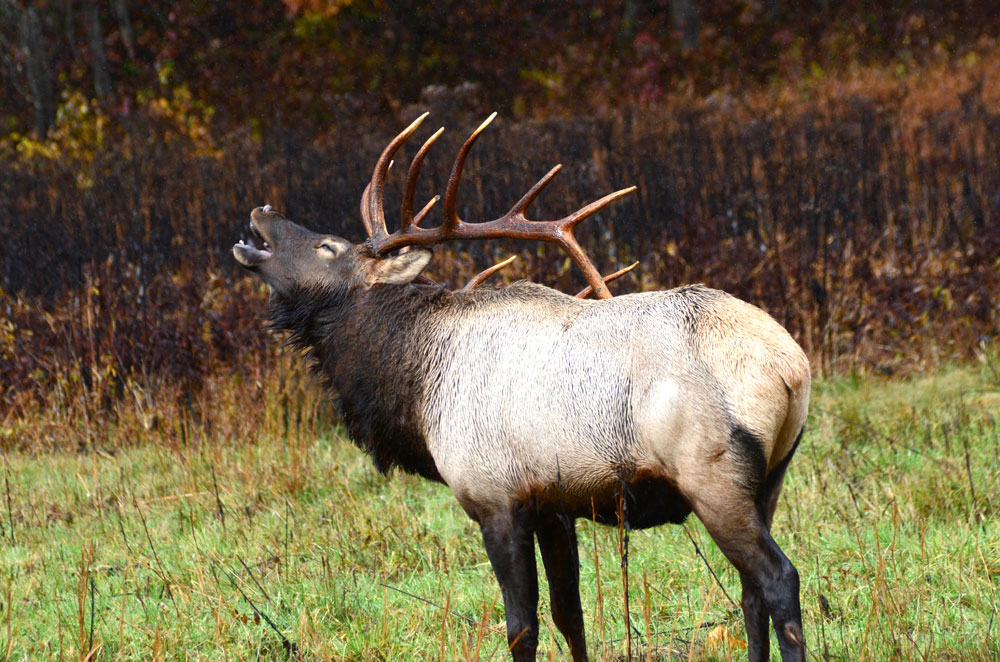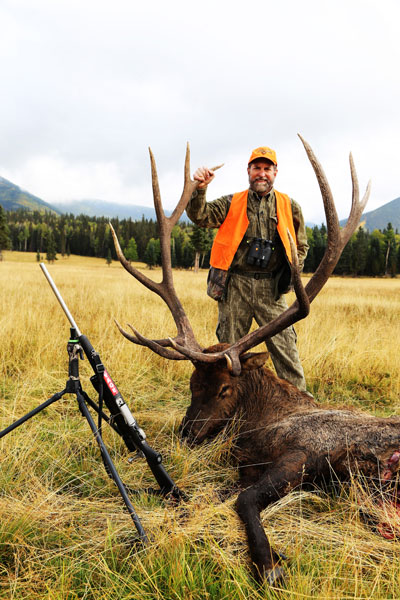provided by John Phillips
Longtime Mossy Oak Pro Will Primos of Flora, Mississippi, has been hunting elk every year since 1988. He said, “I’ve had some fantastic opportunities in my lifetime to call in hundreds of bull elk.” Primos, the creator of Primos Hunting hunts for elk in three states annually. He’s been producing videos and products for the elk-hunting industry for many years. “We wanted to get the public excited about not just elk but hunting and protecting them as well,” he said. “We’re strong supporters of the Rocky Mountain Elk Foundation and its mission.” Primos doesn’t just call and take elk himself, he also guides and calls for other people. Primos has taken or called more than 200 elk for others for his videos, “Primos The Truth 19: Big Bulls Video.”

For 32 years, I’ve been hunting and calling elk. I’ve probably called in 300 bull elk throughout my entire career, but I haven’t killed nearly as many. However, I may hunt with 10 or 12 other people during the season. When I call in bulls for them, I may call in as many as 10-20 elk before the hunter takes the shot. I don’t say this to brag, but it explains how I’ve gotten my education on hunting and calling elk. Over time, I’ve been able to learn what does and doesn’t work to get a bull elk within range for a bowhunter or gun hunter.
When I do seminars, one of the first questions I’m asked is, “What elk call do you recommend for a beginner elk hunter?” Regardless of whether you live out West, or if you’re an eastern hunter going hunting in the West, most elk hunters don’t live in a place where they can hear elk every day, which makes learning the language of an elk more difficult. The primary language an elk hunter needs to learn to be successful is the language of the cow elk, since the bull elk is searching for a cow. Therefore, if you learn that language as well as what to say and when to say it, you’re much more likely to get a bull within range as opposed to using the vocalizations of a bull.
Now having said that, there are some great advantages of learning the bull’s language also. The call that I recommend for most beginning elk hunters is the Primos Hoochie Mama, a mechanical elk call that allows you to push the call with your finger to create the high to low sound of a cow elk. The cow call is what I term as a sliding note as opposed to a breaking-type note like a turkey call. It’s much easier to use and learn the sound of a cow elk as opposed to a mouth call or an open-reed call. A mouth call like the Hyper Lip or the Mewie Grande are great calls, but the Hoochie Mama, I believe, is the best call for the beginner elk hunter to use. It’s easy and effective.
 The first thing that an elk hunter must do when he hears an elk bugle, growl or make any other sounds is to check the wind. You’ve got to know which way the wind is blowing, so the elk won’t smell you. To be a successful elk hunter, the wind has to be in your face to keep your scent from traveling in the elk’s direction. One of the reasons my friends and I have been so successful with taking elk is that we always have three or four people on the hunt with us - including the shooter, the caller, the videographer and sometimes, a guide. When we hear an elk or reach the place where we want to be before we call the elk, we make sure that we’re not in a really open area. We want the elk to come looking for us. This means that we rarely, if ever, get behind any type of cover.
The first thing that an elk hunter must do when he hears an elk bugle, growl or make any other sounds is to check the wind. You’ve got to know which way the wind is blowing, so the elk won’t smell you. To be a successful elk hunter, the wind has to be in your face to keep your scent from traveling in the elk’s direction. One of the reasons my friends and I have been so successful with taking elk is that we always have three or four people on the hunt with us - including the shooter, the caller, the videographer and sometimes, a guide. When we hear an elk or reach the place where we want to be before we call the elk, we make sure that we’re not in a really open area. We want the elk to come looking for us. This means that we rarely, if ever, get behind any type of cover.
The shooter will stand in front of, behind or beside a big tree. Next, the shooter will start ranging different landmarks with his range finder. Then, when a bull walks past one of those landmarks, he knows the distance he is from the elk and can adjust his sights for that range (if bowhunting). You don’t have to worry about a cameraman getting behind the shooter, if you’re not filming. However, once the shooter is in position, the caller starts backing away from the shooter, keeping the wind in his favor and staying about 75-150 yards away behind the shooter. He also needs to be slightly to one side of the shooter, so the elk will come into the shooter broadside.
By setting up this way, when the bull elk comes in, he’ll stop at least 75 yards away from where he hears the call coming. A bull is tall and can see a long way. He wants to see the cow, if possible, before he goes to her. When he gets to that 75 yards, he’ll stand there and bugle to the cow he hears calling, because he doesn’t want to go to that cow knowing that every predator in the woods can hear the same thing. He’s cautious, because he easily can get a horn put in his side by another bull or be attacked by a mountain lion or a bear. Once the bull finally walks in, he’ll come in broadside and stop right in front of the shooter. Many seasoned elk hunters know this tactic, but many elk hunters don’t. Some people don’t like to take a caller with them but prefer to be both the shooter and the caller. However, after years of hunting and filming elk at Primos, we’ve found this system pays off in big bulls more consistently than having the same person shoot and call, especially when bowhunting.
When Ronnie “Cuz” Strickland of Mossy Oak and I first started hunting together, one of us would run the camera and do the calling, while the other was the shooter. We soon learned that when the videographer or the hunter did the calling, and we happened to find a stupid bull that would come straight in, that bull often would stop at 20 yards and look straight at us. Then the only shot that a shooter might have would be at that bull’s throat, which was only about the size of a softball or a grapefruit. If the elk moved at the sound of the bow when you shot, you’d usually make a bad shot and probably only wound the bull. That’s why the broadside shot is worth the work.



























